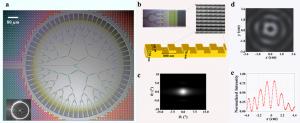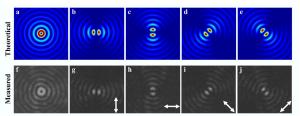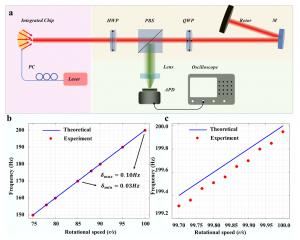On-Chip Generation of Bessel-Gaussian Beam for Long-Range Sensing
FAYETTEVILLE, GA, USA, August 16, 2023/EINPresswire.com/ -- The Bessel beam provided by the existing approaches cannot support long-range sensing. Here, we propose a integrated silicon photonic chip with concentrically-distributed grating arrays to generate the Bessel-Gaussian beam with a long distance. The spot is measured at 10.24m with the operating wavelength from 1500nm to 1630nm. We also measured the rotation speeds and distance of the rotating target to verify its practicability. It is expected that Bessel-Gaussian beams will be widely used in laser radar, and laser sensing.
The Bessel beam, with a significant depth of field and self-healing characteristics, has been applied in widespread applications, including quantum entanglement, underwater 3D imaging, optical micro-manipulation, microscope, and so on. However, these methods, such as circular slit and lens, axicon, spatial light modulator (SLM), are complicated due to the usage of bulky optical elements and hinder the Bessel beam generation system from being applied in practical applications. Recently, several compact systems have been proposed to generate Bessel beams by using photonic integrated circuits (PICs), meta-surfaces, integrated waveguide, and 3D-printed fiber. But the propagation distance of Bessel beams generated by the above technologies is short , which significantly restricts the applications of the Bessel beam in scenarios requiring long propagation distances.
In a new work published in Light Science & Application, a team of scientists, led by Professor Junfeng Song from State Key Laboratory on Integrated Optoelectronics, College of Electronic Science and Engineering, Jilin University, Changchun, China, Peng Cheng Laboratory, Shenzhen, China and co-workers have proposed an unprecedented structure based on silicon photonic grating arrays to generate the Bessel Gaussian beam (BGb) with a long propagation distance (measured 10.24 m). The grating arrays are concentrically distributed on the chip. Moreover, the BGb profiles operated at wavelength range from 1500 nm to 1630 nm are obtained. The spatial distribution of the light intensity follows the first kind of Bessel function. Last but not the least, they also applied the azimuthally polarized BGb to measure rotation speed and distance of a target simultaneously. By the compact size, low cost, and mass production potential of the integrated process, The reported method and technique is promising to readily enable the Bessel-Gaussian beam in widespread optical communication and micro-manipulation applications.
The group summarized the principle of their integrated silicon photonic chip to produce long-distance Bessel-Gaussian beams:
“The BGb can be obtained by the superposition of a series of Gaussian beams. The process is not only related to the emission angle , but also to the divergence half-angle of Gaussian beams. Due to the coherence between the Gaussian beams and the symmetry of the circular distribution, Bessel-Gaussian beams are formed in the overlapping area. The emission angle and divergence angle of the Gaussian beam determine the spatial position of the overlapping area. In theory, the overlapping area can reach infinity.”
“Next, In order to produce long distance BGb, the waveguide structure is carefully designed, especially grating arrays width and grating period. We have done lots of simulation, and finally determined their size. As shown in Fig.1, the whole ring structure has a diameter of 870 μm, and 64-channel grating emitters arranged circularly. The photonic chip is fabricated on a silicon-on-insulator (SOI) substrate by the Singapore Advanced Micro Foundry (AMF) standard 130 nm 8-inch CMOS process.”
“Rotation is a fundamental phenomenon in nature and an effective approach to measure rotation speed is essential to reveal physics characteristics, manage precise machinery and analyze the composition of celestial bodies. To demonstrate the functionality of the generated BGb (shown in Fig.2), we also experimentally measure the rotation speeds of a spinning object via the rotational Doppler Effect and the distance through the phase laser ranging principle. The on-chip BGb can provide an integrated solution for effective rotation measurement.”
“Since the area of this device is less than 1 square millimeter, and the cost of a single device will be reduced to less than 50 cents in mass production. This low-cost, high-quality and long-distance BGb generator on-chip is the key to the future Bessel beam in large-scale, miniaturized and highly stable application scenarios” they added.
###
References
DOI
10.1038/s41377-023-01133-2
Original Source URL
https://doi.org/10.1038/s41377-023-01133-2
Funding information
This work is supported by National Key R&D Program of China under Grants No. 2022YFB2804504; The National Natural Science Foundation of China under Grants No. 62090054, 61934003, 62105173 and 62105174; Major scientific and technological program of Jilin Province under Grants No. 20200501007GX and 20210301014GX. Program for JLU Science and Technology Innovative Research Team (JLUSTIRT,2021TD-39)
About Light: Science & Applications
The Light: Science & Applications will primarily publish new research results in cutting-edge and emerging topics in optics and photonics, as well as covering traditional topics in optical engineering. The journal will publish original articles and reviews that are of high quality, high interest and far-reaching consequence.
The Bessel beam, with a significant depth of field and self-healing characteristics, has been applied in widespread applications, including quantum entanglement, underwater 3D imaging, optical micro-manipulation, microscope, and so on. However, these methods, such as circular slit and lens, axicon, spatial light modulator (SLM), are complicated due to the usage of bulky optical elements and hinder the Bessel beam generation system from being applied in practical applications. Recently, several compact systems have been proposed to generate Bessel beams by using photonic integrated circuits (PICs), meta-surfaces, integrated waveguide, and 3D-printed fiber. But the propagation distance of Bessel beams generated by the above technologies is short , which significantly restricts the applications of the Bessel beam in scenarios requiring long propagation distances.
In a new work published in Light Science & Application, a team of scientists, led by Professor Junfeng Song from State Key Laboratory on Integrated Optoelectronics, College of Electronic Science and Engineering, Jilin University, Changchun, China, Peng Cheng Laboratory, Shenzhen, China and co-workers have proposed an unprecedented structure based on silicon photonic grating arrays to generate the Bessel Gaussian beam (BGb) with a long propagation distance (measured 10.24 m). The grating arrays are concentrically distributed on the chip. Moreover, the BGb profiles operated at wavelength range from 1500 nm to 1630 nm are obtained. The spatial distribution of the light intensity follows the first kind of Bessel function. Last but not the least, they also applied the azimuthally polarized BGb to measure rotation speed and distance of a target simultaneously. By the compact size, low cost, and mass production potential of the integrated process, The reported method and technique is promising to readily enable the Bessel-Gaussian beam in widespread optical communication and micro-manipulation applications.
The group summarized the principle of their integrated silicon photonic chip to produce long-distance Bessel-Gaussian beams:
“The BGb can be obtained by the superposition of a series of Gaussian beams. The process is not only related to the emission angle , but also to the divergence half-angle of Gaussian beams. Due to the coherence between the Gaussian beams and the symmetry of the circular distribution, Bessel-Gaussian beams are formed in the overlapping area. The emission angle and divergence angle of the Gaussian beam determine the spatial position of the overlapping area. In theory, the overlapping area can reach infinity.”
“Next, In order to produce long distance BGb, the waveguide structure is carefully designed, especially grating arrays width and grating period. We have done lots of simulation, and finally determined their size. As shown in Fig.1, the whole ring structure has a diameter of 870 μm, and 64-channel grating emitters arranged circularly. The photonic chip is fabricated on a silicon-on-insulator (SOI) substrate by the Singapore Advanced Micro Foundry (AMF) standard 130 nm 8-inch CMOS process.”
“Rotation is a fundamental phenomenon in nature and an effective approach to measure rotation speed is essential to reveal physics characteristics, manage precise machinery and analyze the composition of celestial bodies. To demonstrate the functionality of the generated BGb (shown in Fig.2), we also experimentally measure the rotation speeds of a spinning object via the rotational Doppler Effect and the distance through the phase laser ranging principle. The on-chip BGb can provide an integrated solution for effective rotation measurement.”
“Since the area of this device is less than 1 square millimeter, and the cost of a single device will be reduced to less than 50 cents in mass production. This low-cost, high-quality and long-distance BGb generator on-chip is the key to the future Bessel beam in large-scale, miniaturized and highly stable application scenarios” they added.
###
References
DOI
10.1038/s41377-023-01133-2
Original Source URL
https://doi.org/10.1038/s41377-023-01133-2
Funding information
This work is supported by National Key R&D Program of China under Grants No. 2022YFB2804504; The National Natural Science Foundation of China under Grants No. 62090054, 61934003, 62105173 and 62105174; Major scientific and technological program of Jilin Province under Grants No. 20200501007GX and 20210301014GX. Program for JLU Science and Technology Innovative Research Team (JLUSTIRT,2021TD-39)
About Light: Science & Applications
The Light: Science & Applications will primarily publish new research results in cutting-edge and emerging topics in optics and photonics, as well as covering traditional topics in optical engineering. The journal will publish original articles and reviews that are of high quality, high interest and far-reaching consequence.
Wendy Chen
TranSpread
+1 865-405-5638
email us here
Legal Disclaimer:
EIN Presswire provides this news content "as is" without warranty of any kind. We do not accept any responsibility or liability for the accuracy, content, images, videos, licenses, completeness, legality, or reliability of the information contained in this article. If you have any complaints or copyright issues related to this article, kindly contact the author above.



